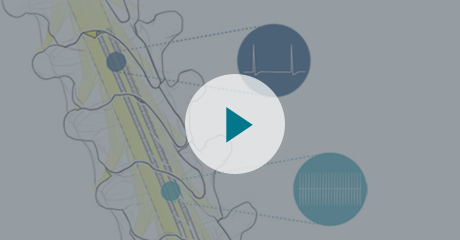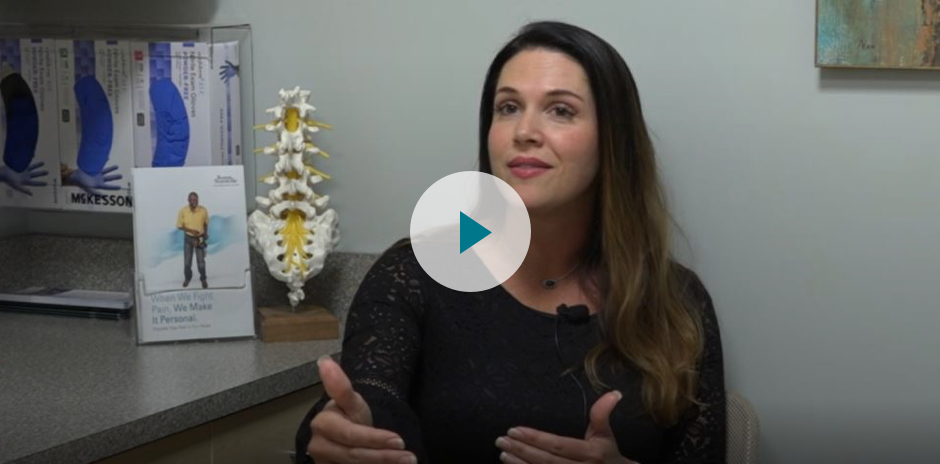Pain Medicine Products > Spectra WaveWriter™ SCS System
Spectra WaveWriter™ SCS System
Every chronic pain patient—and how he or she responds to any specific treatment—is unique. The Spectra WaveWriter Spinal Cord Stimulator (SCS) System allows you to provide patients with personalized, drug-free therapy that is clinically proven1 to help reduce chronic pain for a wide range of patients. See indications for use.

Backed By Science
- Multiple therapy options deliver superior outcomes in long-term implanted SCS patients.1
- Effective sub-perception therapy requires accurate targeting and dosing of the stimulation field.2

Combination Therapy
- Features the proprietary Contour™ sub-perception algorithm* that helps you easily find and keep the optimal target by delivering a personalized stimulation field over multiple vertebral levels
- The Illumina 3D™ Algorithm is engineered to provide precise targeting using a 3D anatomical model of the spinal cord

mySCS™
- Personalized Goal Setting
- Real-Time Expert Support
- Simple Progress Tracking
- Trial Summary Report
Clinically Proven Pain Relief
Metzger WaveWriter Study
A multicenter, consecutive, real-world study with n=420 subjects demonstrated3:
- 66% of subjects (277 of 420) reported a pain score of 2 or less
- 23% of subjects (97 of 420) reported a pain score of 0 or pain-free
- 5.0 point improvement in overall pain (NRS) sustained up to 12 months (p < 0.0001)


A Physician’s Perspective
“We were able to use two programs and stimulate two neural targets simultaneously to give him the best results.” – Dr. Courtney Auman
Get More Info

Request a Representative

Are You a Physician Using Boston Scientific SCS?
Are You a Patient with Chronic Pain?
The Spectra WaveWriter Advantage


Connect to Innovation
More Pain Management Solutions


LSS Treatment


RF Ablation


SCS Portfolio
References
- North et al., WHISPER RCT, Neuromodulation 2019.
- Thomson et al, PROCO RCT, Neuromodulation 2018.
- Metzger et al, Outcomes Using an SCS Device Capable of Delivering Combination Therapy and/or Advanced Waveforms/Field Shapes, INS 2019.
- Boston Scientific Spectra Wavewriter DFU (ARTEN600017308 A).
- Medtronic Intellis™ Implant Manual (M946871A002 Rev C).
- Proclaim™ Implantable Pulse Generator Manual 2017-11 (ARTEN600017308 A).
- Nevro Physician Implant Manual (11051 Rev A 2015-01-16).
*Sub-perception stimulation has been demonstrated to be safe and effective in patients who have been treated successfully with conventional, paresthesia-inducing stimulation for at least six months. Full stimulation parameter ranges and options for both paresthesia based and sub-perception therapy are available for clinician’s use throughout the patient’s experience and treatment with SCS. **Combination therapy is 1khz plus standard rate.
Indications for Use:
The Boston Scientific Spinal Cord Stimulator Systems are indicated as an aid in the management of chronic intractable pain of the trunk and/or limbs including unilateral or bilateral pain associated with the following: failed back surgery syndrome, Complex Regional Pain Syndrome (CRPS) Types I and II, intractable low back pain and leg pain. Associated conditions and etiologies may be: radicular pain syndrome, radiculopathies resulting in pain secondary to failed back syndrome or herniated disc, epidural fibrosis, degenerative disc disease (herniated disc pain refractory to conservative and surgical interventions), arachnoiditis, multiple back surgeries.
Patients contraindicated for permanent SCS therapy are those who:
- are unable to operate the SCS system
- have failed trial stimulation by failing to receive effective pain relief
- are poor surgical risks
- are pregnant
Unauthorized Modification.
Unauthorized modification to the medical devices is prohibited. System integrity could be compromised and harm or injury to the patient could occur if the medical devices are subjected to unauthorized modification.
Heat Due to Charging.
Patients should not charge while sleeping. This may result in a burn. While charging, the Charger may become warm. It should be handled with care. Failure to use the Charger with either the Charging Belt or an adhesive patch, may result in a burn. If patients experience pain or discomfort, they should cease charging and contact Boston Scientific.
Magnetic Resonance Imaging (MRI).
The Spectra WaveWriter SCS System with ImageReady MRI Technology is “MRI-Conditional” only when exposed to the MRI environment under the specific conditions defined in the ImageReady™ MRI Guidelines for Spectra WaveWriter Spinal Cord Stimulator System.
Pediatric Use.
The safety and effectiveness of spinal cord stimulation has not been established for pediatric use.
Diathermy.
Shortwave, microwave and/ or therapeutic ultrasound diathermy should not be used on SCS patients. The energy generated by diathermy can be transferred through the Stimulator system, causing tissue damage at the lead site and resulting in severe injury or death. The IPG, whether it is turned on or off, may be damaged.
Implanted Stimulation Devices.
Spinal cord stimulators may interfere with the operation of implanted sensing stimulators such as pacemakers or cardioverter defibrillators. The effect of implanted stimulation devices on neurostimulators is unknown.
Stimulator Damage.
Burns may result if the pulse generator case is ruptured or pierced and patient tissue is exposed to battery chemicals. Do not implant the device if the case is damaged.
Postural Changes.
Patients should be advised that changes in posture or abrupt movements may cause decreases, or uncomfortable or painful increases in the perceived stimulation level. Patients should be advised to turn down the amplitude or turn off the IPG before making posture changes. If using therapy that does not produce a sensation (subperception), postural changes are less likely to affect the patient. Important: If unpleasant sensations occur, the IPG should be turned off immediately.
Electromagnetic Interference.
Strong electromagnetic fields can potentially turn the Stimulator off, or cause uncomfortable or jolting stimulation or affect wireless communication. Patients should be counseled to avoid or exercise care around:
- Theft detectors or security screeners such as those used at entrances/exits of department stores, libraries, and other public establishments, and/or airport security screening devices. It is recommended that patients request assistance to bypass the device. If they must proceed through the device, the patient should turn off the Stimulator and proceed with caution, moving through the center of the screener as quickly as possible.
- Power lines or power generators
- Electric steel furnaces and arc welders
- Large, magnetized stereo speakers
- Tag deactivators such as those found in retail stores and libraries.
If the patient is near these devices, he may become aware of changing stimulation levels. In rare instances, if the stimulation is on, the patient could experience an increase in stimulation level to the point that the sensation is uncomfortably strong or possibly “jolting.” If this happens, the patient should turn off the Stimulator. If the Stimulator suddenly turns off by itself, the patient should first move away from the area. Next, check the stimulation status with the Remote Control by pressing the Unlock button and observing the screen. The implant may need to be recharged before stimulation can be restarted. The patient can refer to the Charging Handbook for further information.
The patient should be counseled to always be aware of his surroundings, particularly near theft detectors/security screeners. He should ask for assistance to go around these devices if he feels at all uncomfortable.
Physician training is required.
Medical Devices/Therapies.
The following medical therapies or procedures may turn stimulation off or may cause permanent damage to the Stimulator, particularly if used in close proximity to the device:
- lithotripsy
- electrocautery
- external defibrillation
- radiation therapy (Any damage to the device by radiation may not be immediately detectable.)
- ultrasonic scanning
- high-output ultrasound
X-ray and CT scans may damage the Stimulator if stimulation is on. X-Ray and CT Scans are unlikely to damage the Stimulator if stimulation is turned off.
If any of the above is required by medical necessity, refer to “Instructions for the Physician” in the DFU.
Ultimately, however, the device may require explantation as a result of damage to the device.
Subperception Therapy.
Subperception stimulation has been demonstrated to be safe and effective in patients who have been treated successfully with conventional, paresthesia-inducing stimulation for at least six months. Full stimulation parameter ranges and options for both paresthesia-based and subperception therapy are available for clinician’s use throughout the patient’s experience and treatment with SCS.
Automobiles and Other Equipment.
Patients using therapy that generates paresthesia should not operate motorized vehicles such as automobiles or potentially dangerous machinery and equipment with the stimulation on. Stimulation must be turned off first in such cases. For these patients, any sudden stimulation changes may distract patients from proper operation of the vehicle, machinery, or equipment.
For therapy that does not generate paresthesia (e.e., subperception therapy) it is less likely that sudden stimulation changes resulting in distraction could occur while having stimulation on when operating moving vehicles, machinery, and equipment.
Post Operative.
During the two weeks following surgery, it is important that patients use extreme care so that appropriate healing will secure the implanted components and close the surgical incisions:
- Patients should not lift objects of more than five pounds.
- Patients should not engage in rigorous physical activity such as twisting, bending, or climbing.
- If new leads were implanted, patients should not raise their arms above their head.
Temporarily, there may be some pain in the area of the implant as the incisions heal. Patients should be instructed that if discomfort continues beyond two weeks, they should contact their physician.
If patients notice excessive redness around the wound areas during this time, they should contact their physician to check for infection and administer proper treatment. In rare cases, adverse tissue reaction to implanted materials can occur during this period.
Patients should consult their physician before making lifestyle changes due to decreases in pain.
Stimulator Location.
Patients should never attempt to change the orientation or “flip” (rotate or spin) the Stimulator. Patients should not “finger” or play with the Stimulator. If the Stimulator flips over in the Patient’s body, it cannot be charged. If the Patient knows that the device has turned, or if stimulation cannot be turned on after charging, the Patient should contact his or her physician to arrange an evaluation of the system. In some cases, the skin over the Stimulator may become very thin over time. If this occurs, Patients should contact their physicians.
Lead Location.
In some instances a lead can move from its original location, and stimulation at the intended pain site can be lost. If this occurs, Patients should consult their physician who may able to restore stimulation by reprogramming the Stimulator in the clinic or repositioning the lead during another operation.
Device Failure.
Stimulators can fail at any time due to random component failure, loss of battery functionality, or lead breakage. If the device stops working even after complete charging (up to four hours), Patients should turn off the Stimulator and contact their physician so that the system can be evaluated.
Operating Temperature.
The operating temperature of the Trial Stimulator, Remote Control, and Programming Wand is 10–40 °C (50–104 °F). For proper operation, do not use the Charger if the ambient temperature is above 35 °C (95 °F).
Storage, Handling and Transport.
Do not expose the Remote Control or Charging System components to excessively hot or cold conditions. Do not leave the devices in your car or outdoors for extended periods of time. The sensitive electronics can be damaged by temperature extremes, particularly high heat. If the Remote Control or the Charging System is to be stored for a period of time without batteries, the storage temperature should not exceed -20 to 60 °C (-4 to 140 °F). Handle the system external components and accessories with care. Do not drop them or submerge them in water. Although reliability testing has been performed to ensure quality manufacturing and performance, dropping the devices on hard surfaces or in water, or other rough handling, can permanently damage these components. Refer to the Limited Warranty for additional information. Upon completion of the Patient Trial, remove the batteries from the Trial Stimulator.
Component Disposal.
Do not dispose of the Remote Control or Charger in fire. The battery in these devices can explode in fire. Dispose of used batteries in accordance with local regulations. The Stimulator should be explanted in the case of cremation, and returned to Boston Scientific. External devices to be disposed of per local regulatory requirements. Please contact your healthcare professional.
Remote Control, Charging System, External Trial Stimulator and Wand Cleaning.
The charging system components can be cleaned using alcohol or a mild detergent applied with a cloth or tissue. The Remote Control, External Trial Stimulator and Programming Wand can be cleaned using a mild detergent applied with a lightly dampened cloth or tissue. Residue from soapy detergents should be removed with a cloth lightly dampened with water. Do not use abrasive cleansers for cleaning. Cleaning wipes for the External Trial Stimulator can also be ordered through Boston Scientific customer service. As an operator of the external devices, perform only the following service and maintenance tasks on the external devices:
- Changing the battery
- Charging the battery
- Cleaning
Ensure that the devices are not in use while performing service and maintenance tasks.
Cell Phones.
While we do not anticipate any interference with cell phones, the full effects of interaction with cell phones are unknown at this time. If there is a concern or a problem is encountered, the patients should contact their physician.
Potential risks are involved with any surgery.
The possible risks of implanting a pulse generator as part of a system to deliver spinal cord stimulation include:
- Lead migration, resulting in undesirable changes in stimulation and subsequent reduction in pain relief.
- System failure, which can occur at any time due to random failure(s) of the components or the battery. These events, which may include device failure, lead breakage, hardware malfunctions, loose connections, electrical shorts or open circuits and lead insulation breaches, can result in ineffective pain control.
- Tissue reaction to implanted materials can occur. In some cases, the formation of reactive tissue around the lead in the epidural space can result in delayed onset of spinal cord compression and neurological/sensory deficit, including paralysis. Time to onset is variable, possibly ranging from weeks to years after implant.
- Skin erosion at the IPG site can occur over time.
- Possible surgical procedural risks are: temporary pain at the implant site, infection, cerebrospinal fluid (CSF) leakage and, although rare, epidural hemorrhage, seroma, hematoma and paralysis.
- External sources of electromagnetic interference may cause the device to malfunction and affect stimulation.
- Exposure to MRI can result in heating of tissue, image artifacts, induced voltages in the neurostimulator and/or leads, lead dislodgement.
- Undesirable stimulation may occur over time due to cellular changes in tissue around the electrodes, changes in electrode position, loose electrical connections and/or lead failure.
- The patient may experience painful electrical stimulation of the chest wall as a result of stimulation of certain nerve roots several weeks after surgery.
- Over time, the Stimulator may move from its original position.
- Weakness, clumsiness, numbness or pain below the level of implantation.
- Persistent pain at the IPG or lead site.
In any event, instruct the patient to contact their physician to inform him/her.
CAUTION: U.S. Federal law restricts this device to sale by or on the order of a physician.
Indications for Use: The Superion® Indirect Decompression System (IDS) is indicated to treat patients suffering from pain, numbness, and/or cramping in the legs (neurogenic intermittent claudication) secondary to a diagnosis of moderate lumbar spinal stenosis. The Superion® Interspinous Spacer is indicated for those patients with impaired physical function who experience relief in flexion from symptoms of leg/buttock/groin pain, with or without back pain, who have undergone at least 6 months of non-operative treatment. The Superion® Interspinous Spacer may be implanted at one or two adjacent lumbar levels in patients in whom operative treatment is indicated at no more than two levels, from L1 to L5.
Contraindications, warnings, precautions, side effects. The Superion® Indirect Decompression System (IDS) is contraindicated for patients who: have spinal anatomy that prevent implantation of the device or cause the device to be unstable in situ (i.e., degenerative spondylolisthesis greater than grade 1), Cauda equina syndrome, or prior decompression or fusion at the index level. Refer to the Instructions for Use provided on www.vertiflex.com for additional Indications for Use, contraindications information and potential adverse effects, warnings, and precautions prior to using this product.
Caution: U.S. Federal law restricts this device to sale by or on the order of a physician.
The Cosman Radiofrequency Generators, associated Radiofrequency Lesion Probes and RF Cannula are indicated for use in procedures to create radiofrequency lesions for the treatment of pain or for lesioning nerve tissue for functional neurosurgical procedures. The Cosman RF Injection Electrodes are used for percutaneous nerve blocks with local anesthetic solution for radiofrequency lesioning of peripheral nerve tissue only.
Warnings: For a patient with a cardiac pacemaker, contact the pacemaker company to determine whether the pacemaker needs to be converted to fixed rate pacing during the radiofrequency procedure. Refer to the Instructions for Use provided with Cosman generators, electrodes and cannulas for potential adverse effects, additional warnings and precautions prior to using these products.
CAUTION: U.S. Federal law restricts this device to sale by or on the order of a physician.


